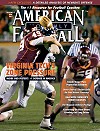AMERICAN FOOTBALL MONTHLY THE #1 RESOURCE FOR FOOTBALL COACHES
Article CategoriesAFM Magazine
|
Making the Most of 3 and OutsThree unique drills for mastering punt return coverageby: Mike Kuchar © More from this issue Sure, some coaches like to preach about how vital special teams are, giving the cliché about it being one-third of a complete game. Yet it usually gets filtered down into pure lip service, with coaches dedicating the majority of their time to what is perceived as more important issues like stopping the spread offense or figuring out how to get their best offensive players in space – special teams becomes an afterthought. But for Lousiana Tech’s new head coach Derek Dooley, he’s sticking to his word of putting special teams on a special pedestal. And why wouldn’t he? He’s lived it. A self made success story, Dooley enrolled at Virginia as a walk-on wide receiver and parlayed his roles on the special teams unit into a full scholarship his sophomore year. As an assistant coach at LSU, Dooley coordinated the special teams....The full article can only be seen by subscribers. Subscribe today!
|
|
|||||||
| HOME |
MAGAZINE |
SUBSCRIBE | ONLINE COLUMNISTS | COACHING VIDEOS |
Copyright 2025, AmericanFootballMonthly.com
All Rights Reserved





